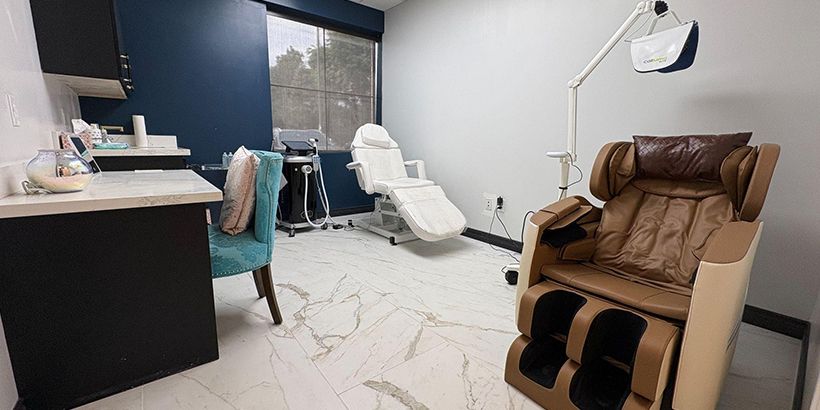Understanding Dry Eye Syndrome
Are your eyes constantly feeling irritated, gritty, or burning? Do you find yourself reaching for eye drops multiple times throughout the day? If so, you're likely experiencing dry eye syndrome - a common but often misunderstood condition that affects millions of Americans,
As a therapeutically licensed Optometrist in Katy, Tx, specializing in ocular disease, I've helped countless patients find lasting relief from dry eyes by identifying and treating the root causes rather than just managing symptoms. In this comprehensive guide, I'll walk you through what really causes dry eye syndrome and advanced treatment options that can provide long-term relief.
Dry eye syndrome occurs when your eyes either don't produce enough tears or produce poor- quality tears that evaporate too quickly. This leads to inadequate lubrication of the eye surface, resulting in discomfort and potential damage to the ocular surface if left untreated.
Common Symptoms of Dry Eyes
- Burning or stinging sensation
- Gritty feeling (like something is in your eye)
- Redness or irritation
- Blurred vision that fluctuates
- Light Sensitivity
- Watery eyes (your eyes' response to irritation - kinda like chapped lips)
- Difficulty wearing contact lenses
- Eye fatigue, especially after screen use
Advanced Dry Eye Treatments

IPL Therapy (Intense Pulse Light)
We take pride in using high-quality therapy options that deliver life-changing, long lasting relief.

Radio Frequency (RF)
Continue reading for more information
"Dry eyes suck. If you come see me it could suck less, or maybe even stop sucking altogether."

What Really Causes Dry Eyes?
Understanding the underlying causes of dry eyes is crucial for effective treatment. Here are the most common factors that we see in our office.
1. Meibomian Gland Dysfunction (MGD)
The meibomian glands in your eyelids produce oils that prevent tear evaporation. When these glands become clogged (sometimes because of makeup application techniques) or dysfunctional, your tears evaporate too quickly. MGD is actually the primary cause of dry eyes in up to 86% of cases!
Signs of MGD include:
- Thickened secretions from the glands (can look like toothpaste)
- Clogged gland openings
- Redness along the eyelid margins
- Decreased number of functioning glands
2. Age-Related Changes
As we age, our tear production naturally decreases. This is particularly common in adults over 50, and especially affects women going through hormonal changes during menopause.
3. Environmental Factors
Our modern lifestyle can contribute significantly to dry eye problems:
- Prolonged screen time (reduced blink rate)
- Air conditioning and heating systems (I'm calling out to you who sleep with the fan in your face at night!)
- Dry, windy, or polluted environments
- High altitudes, dry climates
4. Medications and Medical Conditions
Certain medications and health conditions can cause or worsen dry eyes:
- Antihistamines and decongestants
- Antidepressants and blood pressure medications
- Autoimmune disorders like Sjogren's syndrome
- Diabetes and thyroid disorders
5. Contact Lens Wear
While over-the-counter artificial tears provide temporary relief, they don't address the underlying causes of dry eyes. As a specialist in ocular disease, focus on treatments that tackle the root of the problems.
6. Neurological Dry Eyes
The nerves of the cornea are sending signals to the brain that translate to 'my eyes feel dry' in the absence of dry eyes. Some medical professionals call this "Pain Without Stain" because there are symptoms without measurable markers of dryness.

Meibomian Gland Treatments
Intense Pulse Light (IPL) Therapy
IPL therapy uses specific wavelengths of light to:
- Reduce inflammation around the eyes
- Liquify and release trapped oils
- Kill bacteria that may contribute to gland dysfunction
- Stimulate healthy gland function
Most patients experience significant relief after 3-4 sessions, with measurable improvements in both symptoms and tear film quality.
Radio Frequency (RF) Treatment
This advanced technology delivers controlled heat to:
- Melt thickened meibum (oil) in the glands
- Stimulate collagen production
- Help regenerate damaged meibomian glands
RF treatment is particularly effective for moderate to severe meibomian gland dysfunction.
Prescription Therapies
Beyond in-office procedures, I may also recommend:
- Anti-inflammatory medication drops to reduce ocular surface inflammation
- Prescription eye drops that increase tear production
- Specialized eyelid cleansers to maintain healthy lid margins
Lifestyle and Environmental Modifications
Simple changes can significantly impact dry eye symptoms:
- Regular screen time breaks using the 20-20-20 rule (every 20 minutes, look 20 feet away for 20 seconds)
- Proper positioning of digital devices (below eye level)
- Omega-3 fatty acid supplements
- Adequate hydration
- Use of a humidifier in dry environments

Why Treating the Root Cause Matters
Many patients have tried multiple over-the-counter remedies without success. The difference in my approach is identifying exactly which type of dry eye you have and creating a personalized treatment plan.
When we treat the underlying cause - whether it's MGD, inflammation, or tear production issues - patients experience:
- Longer-lasting relief
- Reduced dependence on artificial tears
- Improved comfort throughout the day
- Prevention of potential corneal damage
- Better quality of life ">
Take the First Step Toward Relief
If you're struggling with dry eyes, know that you don't have to simply manage symptoms indefinitely. With proper diagnosis and targeted treatment, lasting relief is possible.
As a therapeutically licensed Optometrist specializing in ocular disease, I have the advanced training, equipment, and experience needed to identify the specific causes of your dry eye and develop an effective treatment plan.
We invite you to contact our office today to schedule a comprehensive dry eye evaluation. Together, we'll find the solution that works for you!
Share & follow
For any inquiries, please contact:
Carousel Eyecare
Carouseleyecare@gmail.com
eyedoctorkaty.com




